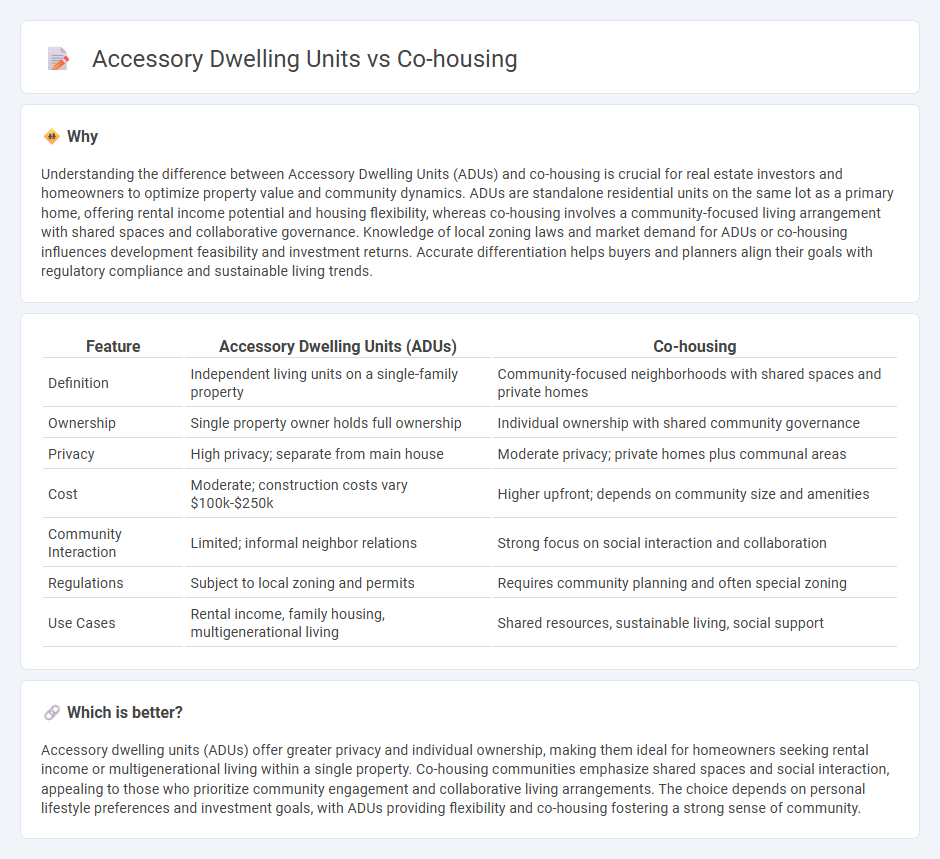
Accessory dwelling units (ADUs) are self-contained living spaces added to existing properties, offering private housing with potential rental income and increased property value. Co-housing involves intentional communities where residents share common spaces and resources while maintaining private homes, fostering social interaction and shared responsibilities. Explore the benefits and considerations of ADUs and co-housing to determine which fits your lifestyle and real estate goals.
Why it is important
Understanding the difference between Accessory Dwelling Units (ADUs) and co-housing is crucial for real estate investors and homeowners to optimize property value and community dynamics. ADUs are standalone residential units on the same lot as a primary home, offering rental income potential and housing flexibility, whereas co-housing involves a community-focused living arrangement with shared spaces and collaborative governance. Knowledge of local zoning laws and market demand for ADUs or co-housing influences development feasibility and investment returns. Accurate differentiation helps buyers and planners align their goals with regulatory compliance and sustainable living trends.
Comparison Table
| Feature | Accessory Dwelling Units (ADUs) | Co-housing |
|---|---|---|
| Definition | Independent living units on a single-family property | Community-focused neighborhoods with shared spaces and private homes |
| Ownership | Single property owner holds full ownership | Individual ownership with shared community governance |
| Privacy | High privacy; separate from main house | Moderate privacy; private homes plus communal areas |
| Cost | Moderate; construction costs vary $100k-$250k | Higher upfront; depends on community size and amenities |
| Community Interaction | Limited; informal neighbor relations | Strong focus on social interaction and collaboration |
| Regulations | Subject to local zoning and permits | Requires community planning and often special zoning |
| Use Cases | Rental income, family housing, multigenerational living | Shared resources, sustainable living, social support |
Which is better?
Accessory dwelling units (ADUs) offer greater privacy and individual ownership, making them ideal for homeowners seeking rental income or multigenerational living within a single property. Co-housing communities emphasize shared spaces and social interaction, appealing to those who prioritize community engagement and collaborative living arrangements. The choice depends on personal lifestyle preferences and investment goals, with ADUs providing flexibility and co-housing fostering a strong sense of community.
Connection
Accessory dwelling units (ADUs) and co-housing both enhance housing density by providing flexible, smaller living spaces within existing communities, promoting affordability and efficient land use. ADUs contribute to co-housing models by enabling multiple generations or households to live closely while maintaining privacy, fostering communal interaction and resource sharing. Both approaches support sustainable urban development by addressing housing shortages and encouraging socially connected neighborhoods.
Key Terms
Shared Ownership
Co-housing communities emphasize shared ownership and collaborative living, where residents collectively own the property and common areas, fostering a strong sense of community and shared responsibility. Accessory dwelling units (ADUs) are secondary housing units on a single-family lot, typically owned by the primary homeowner and not shared among multiple parties. Explore the distinct benefits and challenges of shared ownership in co-housing compared to individual ownership in ADUs for sustainable living solutions.
Community Living
Co-housing communities foster a shared living environment with private homes clustered around communal spaces, promoting social interaction, mutual support, and collaborative decision-making among residents. Accessory dwelling units (ADUs) provide independent living spaces on a single-family property, offering privacy and flexibility while still facilitating proximity and potential community connection. Discover how these innovative housing models redefine community living and enhance social cohesion.
Secondary Unit
Secondary units, or accessory dwelling units (ADUs), provide private, self-contained living spaces on the same lot as a primary residence, offering flexible housing options and increased density without significant land use changes. Co-housing emphasizes community living with shared spaces and resources, whereas ADUs prioritize independent living with full facilities like kitchens and bathrooms. Explore further to understand which housing solution best fits your lifestyle and zoning regulations.
Source and External Links
Cohousing - Wikipedia - Cohousing is an intentional, self-governing, cooperative community where residents live in private homes clustered around shared spaces and amenities, fostering social interaction and communal living.
The Cohousing Association of America - Cohousing combines the privacy of individual homes with communal indoor and outdoor spaces, offering supportive neighborhoods that emphasize social connection and shared resources, though affordability can be a barrier for some.
Texas's first cohousing community nears completion in Houston - Texas's first cohousing development in Houston emphasizes community as its main amenity, featuring shared dinners and group activities for residents.
 dowidth.com
dowidth.com